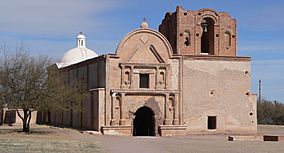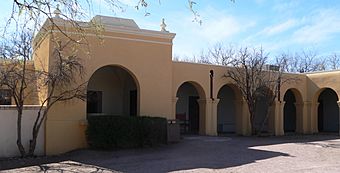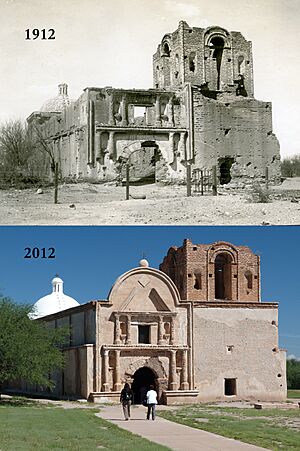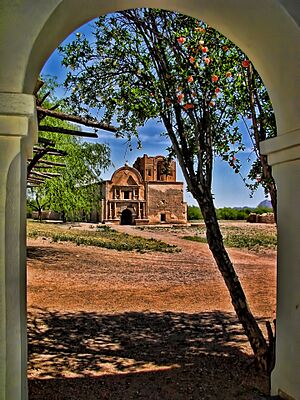Tumacácori National Historical Park facts for kids
Quick facts for kids Tumacácori National Historical Park |
|
|---|---|
|
IUCN Category III (Natural Monument)
|
|

Mission San José de Tumacácori
|
|
| Location | Santa Cruz County, Arizona, United States |
| Nearest city | Nogales, Arizona |
| Area | 360 acres (150 ha) |
| Established | August 6, 1990 |
| Visitors | 40,810 (in 2018) |
| Governing body | National Park Service |
| Website | Tumacácori National Historical Park |
Tumacácori National Historical Park is a special place in southern Arizona. It's found in the beautiful Santa Cruz River Valley. This park covers about 360 acres and is split into three different parts.
The park protects the old ruins of three Spanish mission communities. Two of these missions are so important they are called National Historic Landmarks. The park also has the Tumacácori Museum building, which was built in 1937 and is also a National Historic Landmark.
Contents
Exploring Tumacácori's Past
The first Spanish missions in this area were started in 1691. A Jesuit priest named Padre Eusebio Kino helped create them. Mission San Cayetano de Tumacácori and Mission Los Santos Ángeles de Guevavi are the two oldest missions in southern Arizona.
Later, in the 1750s, a new church was built. This was the Mission San José de Tumacácori. It was built by Franciscan priests across the river from the first Tumacácori mission. A third mission, Mission San Cayetano de Calabazas, was started in 1756.
Visiting the Missions
The main part of the park, the Mission San José de Tumacácori complex, is open for everyone to visit. You can also find the park's visitor center and the Tumacácori Museum here. The museum is in a historic building that looks like an old mission.
The other two missions, Guevavi and Calabazas, are not usually open to the public. However, you can visit them on special tours led by park staff. You need to reserve these tours in advance.
How the Park Was Created
The Tumacácori missions complex was first protected in 1908. President Theodore Roosevelt made it a National Monument. It was added to the National Register of Historic Places in 1966.
In 1990, the monument became a National Historical Park. This meant the Guevavi and Calabazas mission units were added to the park. This helped protect even more of this important history.
The Anza Trail Connection
The park is also part of a historic route. In 1775–1776, the Juan Bautista de Anza Expedition traveled through here. This was the first Spanish journey by land from New Spain to what is now California.
Today, a 4.5-mile (7.2 km) part of the Juan Bautista de Anza National Historic Trail runs along the Santa Cruz River. It connects Tumacácori National Historical Park to Tubac Presidio State Historic Park.
Mission San José de Tumacácori's Story
Mission San José de Tumacácori began in 1691. Padre Eusebio Kino started it at a different spot nearby. It was founded just one day before Mission Los Santos Ángeles de Guevavi. This makes it the oldest Jesuit mission site in southern Arizona.
The first mission was called Mission San Cayetano de Tumacácori. It was built where native O'odham or Sobaipuri people lived, on the east side of the Santa Cruz River.
After a rebellion by the Pima people in 1751, the mission moved. It moved to its current location on the west side of the Santa Cruz River. It was then renamed San José de Tumacácori. By 1848, the mission was left empty and started to fall apart. In 1854, it became part of the U.S. Arizona Territory after the Gadsden Purchase.
Work to fix and protect the mission started in 1908. That's when President Theodore Roosevelt declared it Tumacácori National Monument. In 1990, it became a key part of the new Tumacácori National Historical Park.
Tumacácori Museum: A Window to the Past
|
Tumacácori Museum
|
|

Tumacácori Museum building
|
|
| Location | Tumacácori National Monument (Tumacácori National Historical Park), Tumacacori, Arizona |
|---|---|
| Built | 1937 |
| Architect | Scofield DeLong, et al |
| Architectural style | Mission Revival style architecture, with Spanish Colonial Revival |
| NRHP reference No. | 87001437 |
| Significant dates | |
| Added to NRHP | May 28, 1987 |
| Designated NHL | May 28, 1987 |
The Tumacácori Museum was built in 1937. It was part of what was then Tumacácori National Monument. Today, it's inside Tumacácori National Historical Park.
Scofield Delong designed the museum building. Inside, you can see exhibits that tell the stories of the three historic missions in the park. It also features artwork by the artist Herbert A. Collins.
The museum building itself is a great example of Mission Revival style architecture. It has details from the Spanish Colonial Revival architecture style. Because of its importance, it was named a National Historic Landmark in 1987.
Movies Filmed at the Park
Some movies have used the park as a filming location for their scenes:
- Duel in the Sun (1946)
- Young Guns II (1990)
- Boys on the Side (1995)
See also
- Spanish missions in Arizona
- Spanish missions in the Sonoran Desert
- Hispanic Heritage Site






